Traveling back to the 15th century, we stumble upon an exquisitely beautiful hidden gem, the “secret” château located in the Burgundy region of France. This château, known as the Château de la Chasseigne, became a favorite spot for urban exploration enthusiasts after its owners abandoned it in 2017. Although it’s currently off-limits to adventurous souls, a renowned photographer named Bryan Sansivero, who authored “American Decay,” managed to capture its faded grandeur during his visit last summer. Take a virtual tour of this château, learn the reasons behind its neglect, and discover the efforts to rescue it.

Dubbed the “secret château” within the urban exploration community, the Château de la Chasseigne is discreetly nestled among oak trees just outside the village of Saint-Parize-le-Châtel in Burgundy’s Nièvre department. As you approach this fairytale château, you’ll notice two distinct round towers and an arched gallery on the left side that appear older than the rest of the property. These structures date back to the 15th century and are the only remnants of the original château.

In 1789, the château changed hands and became the property of the de Montrichards, one of France’s most ancient noble families. This transition occurred when a descendant of Robert de la Chasseigne, the original owner, married Count Gabriel-Étienne de Montrichard, a high-ranking general in King Louis XVI’s army. Considering the tumultuous backdrop of the French Revolution, the count might have easily lost both his life and the medieval castle.

Fortunately, the count escaped the guillotine but passed away in 1799 at the age of 44. His eldest son, Louis-Henri, inherited the château, which eventually passed down to his own son, Armand. In 1868, Count Armand de Montrichard is said to have sold two other family estates and invested the proceeds in a grand expansion of the Château de la Chasseigne, giving it a regal neo-Renaissance makeover. Now, let’s take a step inside.

The château’s entrance hall is nothing short of impressive, with its sturdy stone walls and a breathtaking mosaic floor. A magnificent oak staircase adds to the grandeur of the space. Despite some graffiti and tattered wallpaper, the property has been surprisingly well-preserved. Most of the château remains in decent condition, though the roof and plumbing need significant repairs, the Burgundy stone masonry requires repointing, and there are pockets of dry rot.
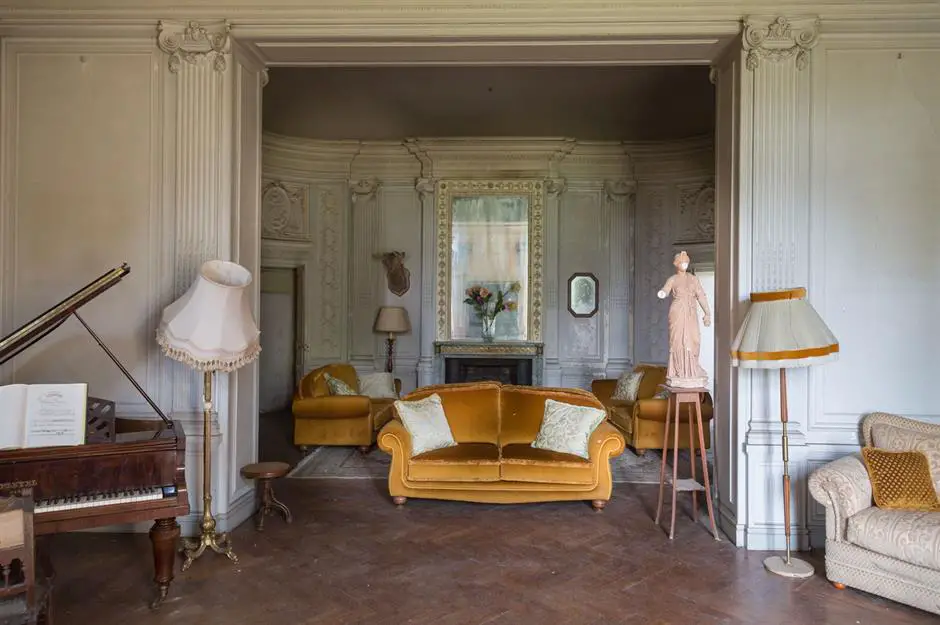
Entering the grand salon, located to the right of the entrance hall, you’ll be captivated by the ornate neo-classical wall paneling and pilasters, which give the room a palatial ambiance. According to French site Souterrain-Lyon, much of the furniture in the château was acquired relatively recently from the Emmaüs charity store chain.

While the absence of genuine heirlooms in the property is somewhat disappointing, there are unexpected treasures scattered throughout the grand salon and other rooms in the château. Notable among them is a grand piano crafted by the renowned Parisian maker Maison Pleyel, which was a favorite of legendary composers such as Chopin, Debussy, and Stravinsky.

Recommended: Explore This Abandoned Mansion In The Middle Of A Virginia Golf Course
To the left of the entrance hall is the château’s dining room. Silk coverings adorned with gold fleur-de-lis, the symbol of French royalty, grace the wood-paneled walls, complemented by exquisite cabinetry and other fine pieces of furniture. The property remained in the Montrichard family for four more generations after Count Armand de Montrichard’s passing in 1875.

The final member of the family to own this magnificent château was supposedly Count Philippe de Montrichard, who likely enjoyed many fine meals in the elegant dining room. However, it seems that he couldn’t keep up with the maintenance of the property. In 2003, the château was reportedly sold to a local architect who, it is said, embarked on a restoration project and filled the rooms with secondhand furniture.

At the rear of the entrance hall, there’s a door leading into the family chapel, complete with a stunning stained glass window. It bathes the sanctuary in a breathtaking, multicolored glow, making it truly special. Given the devoutly Catholic history of the Montrichards, with members of the family holding positions such as canons, abbots, abbesses, and even an archbishop, it’s no surprise that the chapel is one of the château’s most well-appointed spaces.

Moving on, the next room you’ll encounter is the kitchen, which feels like a step back in time, as if it hasn’t been updated since the 19th century. Ancient copper and cast iron pots and pans hang from the walls, work tables that look a century old, and an antique oven transport you to a bygone era, where you can almost imagine the servants bustling about. Now, let’s make our way upstairs.

Despite some creaky floorboards, the oak staircase has stood the test of time remarkably well, a testament to its quality and sturdy construction. Returning to the château’s history, the architect who bought it in 2003 ended up selling the property in 2017, reportedly for a mere euro to two Indonesian real estate investors, possibly with the understanding that they would complete the restoration.

The foreign investors are said to have visited the property only once, for the purpose of signing the necessary sales documents. Locals claim not to have heard from them since. Meanwhile, the property taxes and other dues have allegedly gone unpaid. As we continue up the staircase, we reach the main first-floor landing.
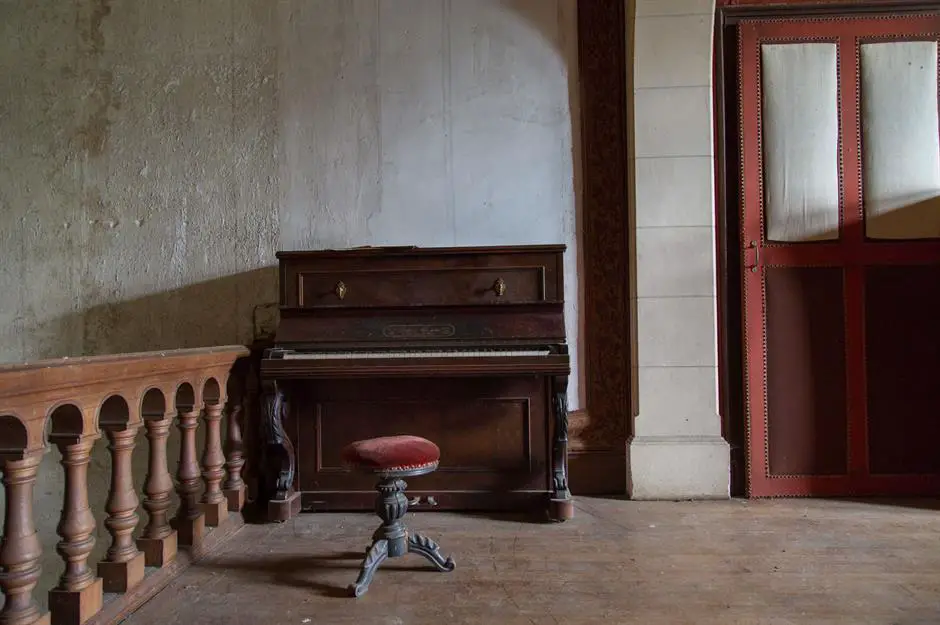
This space is adorned with an upright piano. While it may not be as ornate as the Pleyel piano in the grand salon, it’s likely still quite valuable. In 2017, after the Indonesian investors effectively abandoned the château, word spread that it was sitting vacant, and urban exploration enthusiasts, those who could actually find it, began to explore.
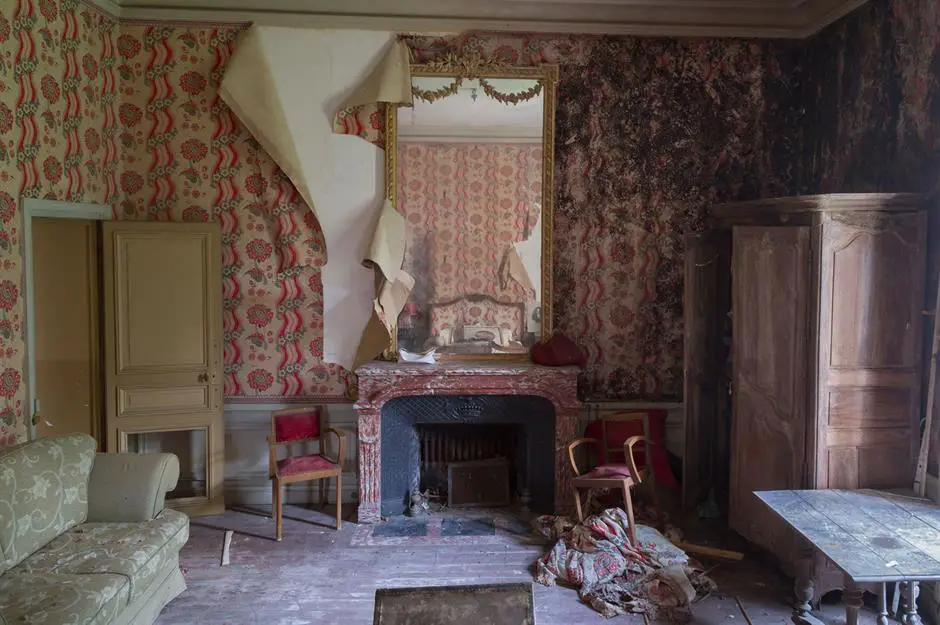
In 2020, the property piqued the interest of four enterprising young individuals passionate about preservation. They formed the Friends of the Château de la Chasseigne Association with the aim of saving it. Hopefully, they’ve focused their efforts on the master bedroom, which is plagued by mold and in need of serious restoration. Take note of the marble fireplace and other exquisite original features; it would be a shame to see them deteriorate further.

The group has initiated a campaign, urging the authorities to take possession of the property and has even devised a plan to transform it into a housing cooperative and a restaurant. This project, which envisions restoring the master bedroom and other rooms to their former splendor, would be funded through crowdfunding and carried out with the broader community in mind.

As you explore the rooms, you’ll discover a variety of intriguing objects, such as the photograph of Pope Pius IX hanging above the bed. Interestingly, since the château captured the attention of urban exploration enthusiasts worldwide, there have been some extravagant claims about its history. For instance, one TikToker even told the New York Post that the château was once the residence of a Norwegian victim of the Titanic disaster.

Recommended: The Most Haunted House in Ireland Is Now Up for Sale — and It Comes With a Private Beach
Moving forward, you’ll encounter one of the château’s charming round turret rooms, straight out of a fairy tale. This particular room features a sleigh bed, a quaint chair, and retro-looking wallpaper that adds to its unique character. Apart from some minor cosmetic issues, the room remains in surprisingly good condition.

The following room appears to be a study or sitting area, though it likely served as a bedroom for most of its existence. Like the master bedroom, it boasts a marble fireplace and other elegant decorative elements. This room is in even better condition, making it an easier task to fully restore.
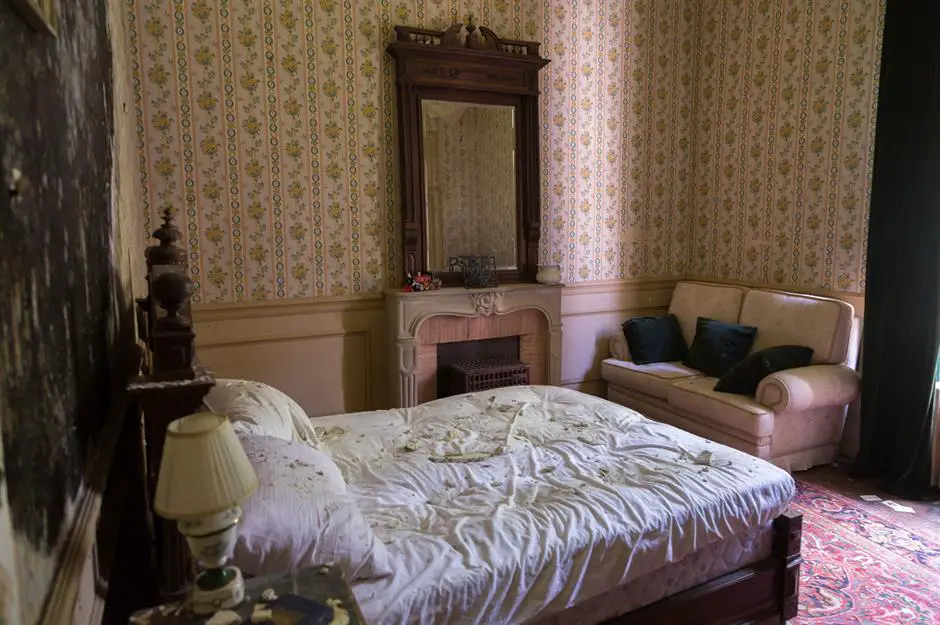
Next up is a smaller bedroom. The fireplace in this room has been painted pink to match the décor. Looking around, there’s visible dry rot, and the debris scattered on the bed suggests that the plaster on the ceiling is deteriorating. It’s evident that this remarkable mansion has been neglected for quite some time.

In addition to the main oak staircase, the château boasts several other staircases, including this one, presumably used by the servants. While less ornate than the principal staircase, it still exudes a certain elegance, with its wrought-iron posts and a dusty wooden banister that gracefully curves at the bottom.

As you continue your journey, you’ll reach the library. Interestingly, among the bookshelves, there are three antique sewing machines and a multitude of old books. The fallen mirror above the fireplace reveals what appears to be a concealed space that might have been used to hide valuable items long ago.
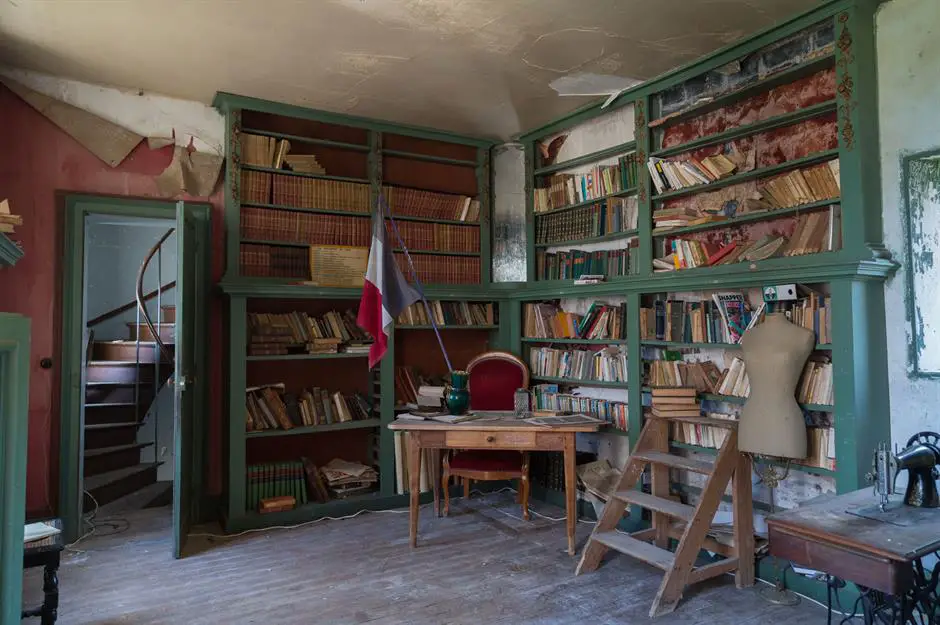
A dressmaking mannequin stands against one of the bookshelves, suggesting that the library was not only used for reading and storing books but also for clothing production. While it’s evident that the space requires replastering, and the walls need some attention, restoring this area should be a relatively straightforward task.

The turret library, accessible from the main library through a spiral staircase, is in dire straits. It’s in a severely deteriorated condition, with a large hole in the ceiling and other serious issues that require immediate attention. Unfortunately, the old books in this space appear to be beyond salvage.

Your next destination seems to be a music room, although its exact purpose remains a mystery waiting to be uncovered. The antique organ embedded in the fireplace adds a peculiar touch. Given its location at the top of the château, it’s possible this room was used by the servants for musical gatherings after a long day’s work.

The rooms in this sprawling abandoned castle seem never-ending. Another reception room, also on the upper floor, contains a chaise longue and some other comfortable pieces of furniture but is notably less grand than the rooms on the lower floors, suggesting it may have been reserved for the servants or possibly served as a nursery.

The succession of rooms continues, with this one likely having served as a child’s bedroom, indicated by the compact sleigh bed in the corner. Debris is scattered across the floor, and the wallpaper is peeling away. Although the floorboards seem intact, they could benefit from a thorough sanding and polishing.

As you ascend the building, the accommodations appear to deteriorate further, possibly indicating vulnerabilities in the roof that need attention. Tucked away in the eaves, this loft space is in a state of disrepair, featuring peeling wallpaper, debris-strewn floorboards, and what appears to be a discarded headboard.

While it may evoke the setting of a romantic Brothers Grimm fairy tale, this castle is in desperate need of a fairy tale rescue. Let’s hope the group working to save the château can achieve just that and preserve it for the future. With its captivating architecture and a history that spans nearly six centuries, this property is far too valuable to be left to decay and neglect.
Recommended: Off market. Wow! Over One Acre Abandoned 1865 Mansion in Virginia Sold For Only $139,900